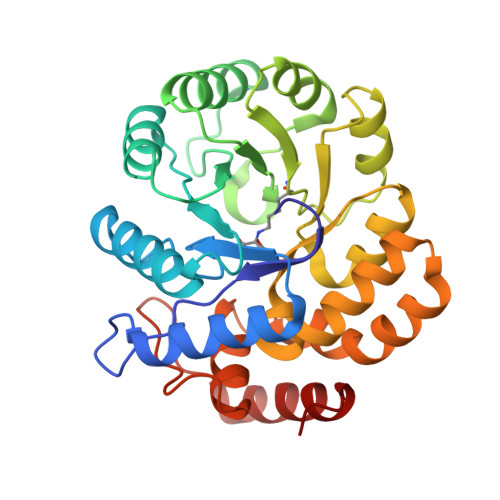Specificity versus catalytic potency: The role of threonine 44 in Escherichia coli dihydrodipicolinate synthase mediated catalysis.
Dobson, R.C., Perugini, M.A., Jameson, G.B., Gerrard, J.A.(2009) Biochimie 91: 1036-1044
- PubMed: 19505526
- DOI: https://doi.org/10.1016/j.biochi.2009.05.013
- Primary Citation of Related Structures:
2PUR - PubMed Abstract:
In plants and bacteria, the branch point of (S)-lysine biosynthesis is the condensation of (S)-aspartate-beta-semialdehyde and pyruvate, a reaction catalysed by dihydrodipicolinate synthase (DHDPS, E.C. 4.2.1.52). In this study, we probe the function of threonine 44 in Escherichia coli DHDPS, with respect to its role in the proton relay. Removal of the hydroxyl moiety of threonine 44, by mutation to valine, significantly attenuates activity (0.1% of wild-type) because the proton relay is broken. It was thus predicted that mutation of threonine 44 to serine would re-establish the proton relay and thus enzymatic activity. Following site-directed mutagenesis and purification to yield the DHDPS-Thr44Ser mutant enzyme, kinetic and structural studies were undertaken. The crystal structure of DHDPS-Thr44Ser showed that the active site was intact and that Ser44 and Tyr107 have some conformational flexibility, which is consistent with the observed loss of activity compared to the wild-type enzyme. Electron density was observed at the active site of DHDPS-Thr44Ser, which was identified as a trapped pyruvate analogue, alpha-ketoglutarate. The activity was indeed found to be increased relative to DHDPS-Thr44Val, but was still reduced to only approximately 8% of that of the wild-type enzyme. Interestingly, there was a shift in the kinetic mechanism, from the substituted-enzyme mechanism, observed in the wild-type, to the ternary-complex mechanism, consistent with the trapped substrate analogue. Increased flexibility in the active site appears to facilitate the binding/reaction of substrate analogues, suggesting that wild-type DHDPS has evolved a relatively rigid active site in order to maintain substrate specificity for pyruvate.
- Department of Biochemistry and Molecular Biology, University of Melbourne, Parkville, Victoria, Australia. rdobson@unimelb.edu.au
Organizational Affiliation:




















